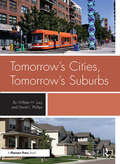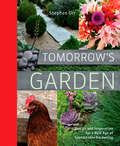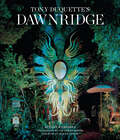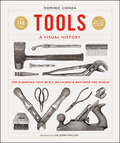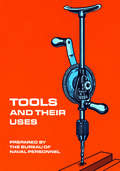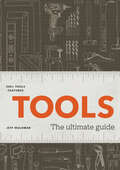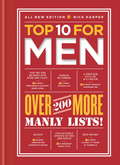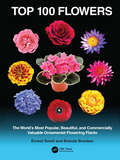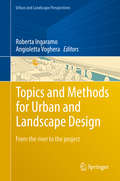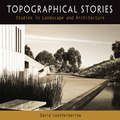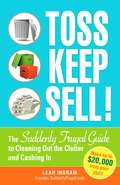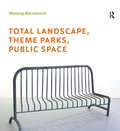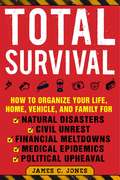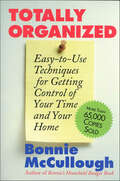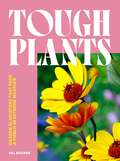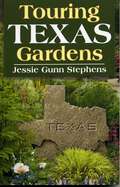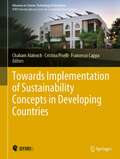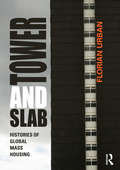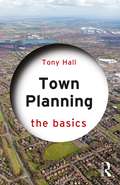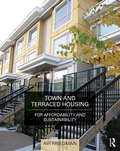- Table View
- List View
Tomorrow's Cities, Tomorrow's Suburbs
by William LucyCities ruled the first half of the 20th century; the second half belonged to the suburbs. Will cities become dominant again? Can the recent decline of many suburbs be slowed? This book predicts a surprising outcome in the decades-long tug-of-war between urban hubs and suburban outposts. The authors document signs of resurgence in cities and interpret omens of decline in many suburbs. They offer an extensive analysis of the 2000 census, with insights into the influence of income disparities, housing age and size, racial segregation, immigration, and poverty. They also examine popular perceptions-and misperceptions-about safety and danger in cities, suburbs, and exurbs that affect settlement patterns. This book offers evidence that the decline of cities can continue to be reversed, tempered by a warning of a mid-life crisis looming in the suburbs. It also offers practical policies for local action, steps that planners, elected officials, and citizens can take to create an environment in which both cities and suburbs can thrive.
Tomorrow's Garden: Design and Inspiration for a New Age of Sustainable Gardening
by Stephen OrrWith a keen eye for aesthetics matched by a strong concern for the environment, garden expert Stephen Orr has developed a sense of what a modern garden should be: small, visually pleasing, and responsible. In Tomorrow's Garden, he presents gardens in 14 American cities that have been scaled back and simplified without sacrificing beauty or innovative design.A devoted supporter of the organic gardening movement, Orr advises gardeners to think about their gardens as part of an interconnected whole with the surrounding environment--with an eye to water usage, local ecology, and preservation of resources. However, for those who are afraid that a sustainable garden means a lack of flora and fauna, Orr believes that a garden, first and foremost, should be a thing of beauty. He encourages flower lovers to plant flowers, and he showcases gardens filled with traditional and exotic plants that are designed with both visual appeal and the environment in mind.With detailed case studies, stunning photographs, and an appendix of resources and information to help gardeners achieve their ecological best, Tomorrow's Garden will teach you the true definition of sustainability and show you how to create beauty without excess in the 21st century and beyond.
Tony Duquette's Dawnridge
by Hutton WilkinsonHutton Wilkinson&’s Tony Duquette&’s Dawnridge chronicles the luxe and historic home&’s transformation by its iconic designer. Foreword by Hamish Bowles Designer Tony Duquette&’s legendary Dawnridge, located in Beverly Hills, is one of the most creatively designed private homes in America. Built in 1949 by Duquette and his wife, Elizabeth, the original structure was a modest 30-by-30-foot box. Hutton Wilkinson purchased the home following Duquette&’s death in 1999, and he has since breathed new life into the estate, broadening the property, adding houses of his own design, and incorporating remarkable objects designed and created by the Duquettes. This book is organized by the three main houses, and Wilkinson elaborates on the spectacular design elements in each room and shares the stories behind the spaces. Tim Street-Porter&’s photographs show both the original and redesigned rooms. &“Walk on the Wild Side. Tony Duquette&’s fantastical designs strut their stuff for a new generation.&” —Architectural Digest
Tony Hunt's Second Sketchbook
by Tony Hunt Sir Norman FosterTony Hunt's Sketchbook illustrates the connection between brain and hand in conceiving structural concepts and details as possible solutions to structures in architecture. This new edition features 100 previously unpublished sketches. These sketches illustrate alternative structural concepts, ideas and details developed by Tony Hunt for over one hundred projects throughout his professional life. They relate directly to projects built and unbuilt in the field of structural engineering and were either produced at the time of relevant design meetings or as a response to a problem posed by an architect and are, therefore, a record of ideas proposed at the particular time. They are a source of design inspiration and an insight into the work of this well respected engineer.
Tools A Visual History: The Hardware that Built, Measured and Repaired the World
by Dominic ChineaA must-read for makers, tinkerers, fixers and creators, The Repair Shop&’s Dominic Chinea shares his knowledge and enthusiasm for the history and practical uses of tools.This book is a beautifully-illustrated celebration of 140 essential tools, their history, their unique appeal and how they are used by creative people to make just about anything. From the workhorses designed to fuel the industrial revolution to the specialist tools that allow highly-skilled artisans to produce ornate creations, this book shines a light on the most interesting tools found in the workshop of expert craftsman Dom Chinea - popular presenter on the BBC&’s award-winning The Repair Shop. A tool is an object with endless possibilities. Contained within each item is the chance to create, to inspire, to repair and improve. It&’s no wonder that scientific studies have shown humans are hardwired to appreciate hardware! From the workhorses designed to fuel the industrial revolution to the specialist tools that allow highly-skilled artisans to produce ornate creations, this book shines a light on the most interesting tools found in the workshop of expert craftsman Dom Chinea. With each entry accompanied by a stunning illustration, this book will become a trusted reference for all creators and craftspeople.Turn the page to explore:- Striking illustrations by award-winning artist Lee John Philips highlight the beauty of each tool- Creative profiles summarising each tool, its history and how to care for it. - Top tips and insights that Dom has gained through years of experience. - A beautiful gift book with a vintage design. A must-read for makers, tinkerers, fixers and creators, Dom Chinea shares his knowledge and enthusiasm for the history and practical uses of tools.
Tools and Their Uses
by U.S. Bureau of Naval PersonnelDo you have trouble with tools — find that they wear out too quickly, find that you can't decide which tools to buy or which tools to use for a specific job, find that little things continually go wrong? The only way to learn to use tools, of course, is by using them, but first you have to know which tools to use and why.This manual, originally prepared for the use of naval personnel, was designed to present the basic hand and power tools that the ordinary person is likely to use. Through a wealth of diagrams, clear explanations, safety tips, and operating instructions you will soon learn the basics of choosing tools and using them as they were meant to be used. Nearly every hand tool you are likely to use around the house is described in the first chapter: hammers, wrenches, screwdrivers, wood saws, planes, wood chisels, metal chisels, dies, drills, files, hacksaws, punches, reamers, taps, clamps, vises, pliers, knives. Chapter two covers the common power tools: drills, grinders, sanders. Chapter three covers measuring tools from rules and tapes to calipers, micrometers, and squares with detailed instructions on how to use each one. Chapter four describes the common nails, screws, bolts, nuts, rivets, and other fasteners you are likely to use. Chapter five describes grinders and shows how to sharpen and care for screwdrivers, chisels, drills, and snips. The final two chapters cover such miscellaneous tasks and tools as metal cutting operations, stripping insulated wire, and soldering techniques.By the time you finish you should know the names, general uses, and correct operation of all the basic tools, fasteners, and measuring devices you are likely to need around the house. You should be able to select tools for a basic kit for doing simple home repairs. And you should be confident in beginning to use tools for yourself to perform all those simple but necessary repair jobs.
Tools: The Ultimate Guide
by Jeff WaldmanA must-have compendium for anyone looking to learn about the fascinating world of over 500 essential tools.This is the book for answering all your tool questions, gaining knowledge before hiring a professional, or simply flipping through just for the joy of learning something new about the objects that shape our world.This expansive guide catalogs more than 500 tools for measuring, cutting, fastening, and shaping—from hammers and saws to wrenches, welders, and drawknives. Throughout these illustrated pages, you'll learn how to care for each tool so it can last a lifetime, as well as learn intriguing tidbits and fascinating histories of each object along the way.TONS OF INFORMATION: This chunky book is filled with detailed information about a wide variety of tools you'd find in a home improvement store; it will earn a spot in your garage, shed, workshop, or studio.EASY TO USE: Learn how to avoid wasting countless hours on head-scratching home repairs, wonky backyard builds, and failed garage tinkering.Perfect for:• New homeowners• Newly independent young adults seeking home literacy• Curious crafters, woodworkers, handymen/handywomen• Fans of THE ELEMENTS OF A HOME or HOW TO DO THINGS.
Top 10 for Men: over 200 more manly lists! (Top 10)
by Nick HarperYou're a man. You love facts. Facts amuse you. The more trivial the better.The most important things in the world - sport, cars, gadgets, beer, meat - come together in this unbeatable collection of lists to feed your manly desire for knowledge and trivia. Discover vital facts and stats on the world's fastest cars, deadliest weapons, shortest football players and strongest drinks, and then wow everyone you know with your findings.
Top 100 Flowers: The World’s Most Popular, Beautiful, and Commercially Valuable Ornamental Flowering Plants
by Ernest Small Brenda BrookesFlowers are universally admired. Flowers are the leading gift expressing love and respect. They prominently decorate our homes and cities, and they accompany all of the major events in human affairs, from birth through marriage and bereavement. Flowers are also of tremendous economic importance, representing billion-dollar industries in numerous countries. Hundreds of thousands of plant species produce flowers, but relatively few dominate the world of cultivated ornamental plants. Top 100 Flowers presents key information and illustrations of the world’s most popular, beautiful, and commercially valuable ornamental flowering plants.Toward these goals, basic information is presented on the identification, appearance, names, history, growth requirements, economic aspects, and problem issues, as well as sources of additional library and online resources. Throughout the text, extensive photos, paintings, and diagrams are provided to illustrate the beauty and applications of the plants. Although the book is encyclopedic in nature, the information given is reduced to essentials and presented in non-technical language. The world’s leading flowering plants are stunningly attractive, and the thousands of illustrations presented were chosen not only for their explanatory and educational value but also to reflect the beauty and charm of the plants. The text relates many of the wonderfully entertaining stories that reflect the intimate relationships of people and our beloved flowers.Features A unique compilation of authoritative, practical, and entertaining information and illustrations addressing the world’s most gorgeous and popular flowers Text is accessible, user-friendly, concise, and well-organized, making numerous topics comprehensible and readable not only by students, but also by the average layperson Wonderfully illustrated: approximately a billion photos, paintings, and diagrams were surveyed and the more than 3,500 chosen for this book represent the finest floral art ever assembled The goal of Top 100 Flowers: The World’s Most Popular, Beautiful, and Commercially Valuable Ornamental Flowering Plants is to provide basic knowledge of practical interest to the horticultural industry, especially students, to choose, develop, and market profitable floral crops, and the public, to choose, grow, and appreciate flowers in their gardens and homes.
Topics and Methods for Urban and Landscape Design
by Roberta Ingaramo Angioletta VogheraThis book combines urban planning and architectural tools in an attempt to overcome the limitations of sectoral measures. In this perspective, it offers a forum for the debate of different approaches used by schools of planning and architecture. It explores strategies by drawing from the potential contributions of cognitive models for decisions, the role of utopian thinking and retrofitting actions and their interconnectedness, the role of cultural legacy for urban and landscape design, the design perspectives about public spaces, and the role of architecture design and urban and regional planning for landscape quality. The book also discusses on design as a process of decision-making that operates as an act of empathy that aligns with human and ecological values - emotional, physical and socio-cultural. Each planning and design act has different possible effects able to help making clear strategic and local actions, contributing to community empowerment and to landscape and local governance. Design activity along the river and multiple experiences (design processes, urban fringe design, agri-urban models, river parks, UNESCO sites, River Contracts, greenbelts and ecological networks), through reflection on design roles, helping to understand the design process and its results at different scales. Roberta Ingaramo, architect, PhD, is Assistant Professor in Architectural and Urban Design, Department of Architecture and Design (DAD), Polytechnic University of Turin (Italy), Master in Conservation of Historic Towns and Buildings, Katholieke Universiteit (Belgium). roberta. ingaramo@polito. it Angioletta Voghera, architect, PhD, is Associate Professor of Urban and Regional Planning, Inter-university Department of Urban and Regional Studies and Planning (DIST), Polytechnic University of Turin (Italy). angioletta. voghera@polito. it
Topographical Stories
by David LeatherbarrowLandscape architecture and architecture are two fields that exist in close proximity to one another. Some have argued that the two are, in fact, one field. Others maintain that the disciplines are distinct. These designations are a subject of continual debate by theorists and practitioners alike.Here, David Leatherbarrow offers an entirely new way of thinking of architecture and landscape architecture. Moving beyond partisan arguments, he shows how the two disciplines rely upon one another to form a single framework of cultural meaning. Leatherbarrow redefines landscape architecture and architecture as topographical arts, the shared task of which is to accommodate and express the patterns of our lives. Topography, in his view, incorporates terrain, built and unbuilt, but also traces of practical affairs, by means of which culture preserves and renews its typical situations and institutions.This rigorous argument is supported by nearly 100 illustrations, as well as examples of topography from the sixteenth, eighteenth, and nineteenth centuries, through the heroic period of early modernism, to more recent offerings. A number of these studies revise existing accounts of decisive moments in the history of these disciplines, particularly the birth of the informal garden, the emergence of continuous space in the landscapes and architecture of the modern period, and the new significance of landform or earthwork in contemporary architecture. For readers not directly involved with either of these professions, this book shows how over the centuries our lives have been shaped and enriched by landscape and architecture.Topographical Stories provides a new paradigm for theorizing and practicing landscape and architecture.
Toss Keep Sell!
by Leah IngramLooking for a way to make money and get your house in order? Toss, Keep, Sell! teaches you how to turn the junk you haven't used (or even seen!) in ages into cash-while organizing your home at the same time. To make decluttering easier than ever, each orderly chapter is organized by rooms and daily tasks and features: Cashing In: A profile of everyday people who have earned big while clearing out Quick Clutter Challenge: Easy ways for you to declutter a space in thirty minutes or less A Keep, Toss, Sell Chart: A visual organizer to help get every room of the house under control Cash Back in This Chapter: What better way to motivate you than to point out potential earnings from one chapter's worth of tips? Under financial and organization whiz Leah Ingram's guidance, you could earn up to $20,000 while organizing your home. So stop wasting your time searching for lost items and start finding out how you can hit it big-without missing a thing!
Toss, Keep, Sell!
by Leah IngramThe American house is one cluttered place. Frugal folks need to get their homes in order and find ways to make money from the junk they no longer need or want. That's where this book comes in!Organized by rooms of the house and tasks of the day, this book becomes a veritable clutter checklist. Each chapter in this reader-friendly guide features:Cashing In: A profile of everyday people who have earned big while clearing outQuick Clutter Challenge: Easy ways for you to declutter a space in thirty minutes or lessA Keep, Toss, Sell Chart: A visual organizer to help get every room of the house under controlCash Back in This Chapter: What better way to motivate you than to point out potential earnings from one chapter's worth of tips?You can forget paying big bucks for a professional organizer. With Leah Ingram as your guide, you'll have extra money--and a home you can be proud of--in no time!
Toss, Keep, Sell!: The Suddenly Frugal Guide to Cleaning Out the Clutter and Cashing In
by Leah IngramThe American house is one cluttered place. Frugal folks need to get their homes in order and find ways to make money from the junk they no longer need or want. That's where this book comes in!Organized by rooms of the house and tasks of the day, this book becomes a veritable clutter checklist. Each chapter in this reader-friendly guide features:Cashing In: A profile of everyday people who have earned big while clearing outQuick Clutter Challenge: Easy ways for you to declutter a space in thirty minutes or lessA Keep, Toss, Sell Chart: A visual organizer to help get every room of the house under controlCash Back in This Chapter: What better way to motivate you than to point out potential earnings from one chapter's worth of tips?You can forget paying big bucks for a professional organizer. With Leah Ingram as your guide, you'll have extra money--and a home you can be proud of--in no time!
Total Landscape, Theme Parks, Public Space (Design and the Built Environment)
by Miodrag MitrasinovicPlacing theme parks from the United States, Europe and Asia in a comparative, multidisciplinary framework, this fascinating book argues that these fantasy environments are an extreme example of the totalization of public space. By illuminating the relationship between theme parks and public space, this book offers critical insights into the ethos of total landscape. Illuminating the relationship between theme parks and public space, the book offers an insight into the ethos, design and expectations of public space in the twenty-first century.
Total Survival: How to Organize Your Life, Home, Vehicle, and Family for Natural Disasters, Civil Unrest, Financial Meltdowns, Medical Epidemics, and Political Upheaval
by James C. JonesKnowing that no survival book can cover every conceivable aspect of surviving in every conceivable situation, in Total Survival, veteran survivalist James C. Jones delivers tips that cover the most likely needs of readers and for which there is useful and practical instruction. His goal is to share a variety of practical survival skills, principles, and ideas in an easy-to read format that will aid the reader in becoming stronger, safer, and more self-reliant. The ten principles of survival that Jones sets out are derived from analysis of true survival accounts. Studies of why some people survived fires, plane crashes, assaults, and other deadly situations while others in the same situations perished confirm that these principles made the difference. Although the data and concepts in Total Survival are derived from accounts of acute disasters—such as tornadoes, floods, earthquakes, and epidemics—they apply equally well to chronic disasters, such as economic decline, shortages, unemployment, climate change, and personal family or health issues. In reality, all of life is a survival challenge, and a survival emergency is just a high-intensity life test. These ten survival principles are the key to success in everyday life, especially during an emergency.
Totally Organized: Easy-to-Use Techniques for Getting Control of Your Time and Your Home
by Bonnie McCulloughGetting organized is one of the biggest challenges in any home today. Pressed for time and bogged down by papers, receipts, household items, and an endless stream of junk mail, Americans need expert ways to get an stay on top of it all. Expert organizer Bonnie McCullough has the answers. In this clear, practical guide, she explains how to:--Take control of household tasks by using a planner, making lists, and setting priorities.--Gain more free time by establishing routines and planning ahead.--Create more space in the kitchen, closets, and elsewhere.--Setup a simple, easy-to-use home-filing system.--Get kids, spouses, and roommates motivated to help keep the household organized.--Establish and stick to a household budget.--Simplify holidays and gift giving.--Work smarter, not harder--when tackling housework, paperwork, and all the little things that drain time and energy from our lives.
Tough Plants: Garden gladiators that pack a punch in extreme weather
by Val BourneA stylish and modern guide to plants that flourish in the extreme weather conditions that have become the new norm.There's nothing more soul-destroying than cultivating your beloved garden with beautiful plants, only to see them die a death from heatwave, frostbite or flooding. In extreme weather, the go-to plants of the past are no longer tough enough to survive and thrive. Enter Tough Plants: 40 of the most irrepressible species that will flourish whatever the weather.With species from across the world, expert advice on planting and garden structure, five perfect partners for each entry and multiple variations for the ultimate garden inspiration, this book is a stylish, practical guide to plants that can literally weather the storm.
Tough Plants: Garden gladiators that pack a punch in extreme weather
by Val BourneA stylish and modern guide to plants that flourish in the extreme weather conditions that have become the new norm.There's nothing more soul-destroying than cultivating your beloved garden with beautiful plants, only to see them die a death from heatwave, frostbite or flooding. In extreme weather, the go-to plants of the past are no longer tough enough to survive and thrive. Enter Tough Plants: 40 of the most irrepressible species that will flourish whatever the weather.With species from across the world, expert advice on planting and garden structure, five perfect partners for each entry and multiple variations for the ultimate garden inspiration, this book is a stylish, practical guide to plants that can literally weather the storm.
Touring Texas Gardens
by Jessie Gunn StephensBeautiful, accessible, even educational public gardens offer delights for travelers all over the state who want to get close to Nature. Visitors can explore a variety of gardens: botanical, estate, lily, rose, herb, cottage, wildflower, and more.
Towards Implementation of Sustainability Concepts in Developing Countries (Advances in Science, Technology & Innovation)
by Chaham Alalouch Cristina Piselli Francesco CappaThis book focuses on sustainability concepts in architecture and urban design, environmental issues, and natural resources. Today it has become essential to reduce carbon emissions, protect habitats, and preserve the delicate ecosystems of our planet. Accordingly, sustainable development has to be improved by decreasing the consumption of non-renewable resources, in order to help nature replenish itself.Further, it highlights the efforts that have been made by architects, environmentalists, engineers, students, planners and everyone in between in order to improve sustainability in various developing communities and countries.
Towards an Urban Renaissance
by The Urban Task ForceThe Urban Task Force, headed by Lord Rogers, one of the UK's leading architects, was established by the Department of Environment, Transport and Regions (DETR) to stimulate debate about our urban environment and to identify ways of creating urban areas in direct response to people's needs and aspirations. Their findings, conclusions and recommendations were presented in a final report to Government Ministers in Summer 1999 and form the basis of this important new illustrated book.
Tower and Slab: Histories of Global Mass Housing
by Florian UrbanTower and Slab looks at the contradictory history of the modernist mass housing block - home to millions of city dwellers around the world. Few urban forms have roused as much controversy. While in the United States decades-long criticism caused the demolition of most mass housing projects for the poor, in the booming metropolises of Shanghai and Mumbai remarkably similar developments are being built for the wealthy middle class. While on the surface the modernist apartment block appears universal, it is in fact diverse in its significance and connotations as its many different cultural contexts. Florian Urban studies the history of mass housing in seven narratives: Chicago, Paris, Berlin, Brasilia, Mumbai, Moscow, and Shanghai. Investigating the complex interactions between city planning and social history, Tower and Slab shows how the modernist vision to house the masses in serial blocks succeeded in certain contexts and failed in others. Success and failure, in this respect, refers not only to the original goals – to solve the housing crisis and provide modern standards for the entire society – but equally to changing significance of the housing blocks within the respective societies and their perception by architects, politicians, and inhabitants. These differences show that design is not to blame for mass housing’s mixed record of success. The comparison of the apparently similar projects suggests that triumph or disaster does not depend on a single variable but rather on a complex formula that includes not only form, but also social composition, location within the city, effective maintenance, and a variety of cultural, social, and political factors.
Town Planning: The Basics (The Basics)
by Tony HallThe planning of urban and rural areas requires thinking about where people will live, work, play, study, shop and how they will get about the place, and to devise strategies for long time periods. Town Planning: The Basics provides a general introduction to the components of urban areas, including housing, transportation and infrastructure, and health and environment, showing how appropriate policies can be developed. Explaining planning activity at different scales of operation, this book distinguishes between the "big stuff", the grand strategy for providing homes, jobs and infrastructure; the "medium stuff", the design and location of development; and the "small stuff" affecting mainly small sites and individual households. Planning as an activity is part of a complex web stretching way beyond the planning office, and this book provides an overview of the many components needed to create a successful town. It is invaluable to anyone with an interest in planning, from students learning about the subject for the first time to graduates thinking about embarking on a career in planning, to local councillors on planning committees and community boards.
Town and Terraced Housing: For Affordability and Sustainability
by Avi FriedmanRecent societal changes have brought about renewed interest from architects, town planners, housing officials and the public in terraces and townhouses. The small footprint that this style of house occupies allows a sustainable high density approach to habitation, slowing sprawl and creating energy-efficient affordable living. Townhouses have been used for hundreds of years, and their evolution is covered from their inception right up to the present day. With the changing demographics of buyers in mind, Avi Friedman details how the design of these houses can be adapted to keep-up with contemporary needs. Friedman uses a systematic approach to cover the many facets of townhouses from interior design and construction methods, to urban planning issues like adjusting to the site’s natural conditions, street configurations and open spaces. This approach creates a book which will be a valuable resource for those involved in the planning, design and creation of terraced and town houses. Over 150 detailed diagrams and plans, and eighty photos, illustrate the essential elements of this style of housing. In the final chapter, lessons learnt throughout the book are draw together in ten broad ranging case study projects, showing how the various aspects can be put into practice.
